Mark Saks, MD, MPH
- Assistant Professor
- Department of Emergency Medicine
- Drexel University College of Medicine
- Philadelphia, Pennsylvania
Atorlip-5 dosages: 5 mg
Atorlip-5 packs: 60 pills, 90 pills, 120 pills, 180 pills, 270 pills, 360 pills
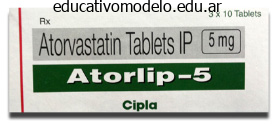
Discount atorlip-5 5 mg mastercard
Frequently seen scientific findings embrace retinitis pigmentosa, cerebellar ataxia, myopathy, cardiomyopathy, and diabetes. Frequently associated medical findings include: � Primary intellectual incapacity. Frequently associated medical findings include dystonia and cardiac pre-excitation syndromes. Cerebellum and spinal twine grey matter may be concerned, but cortex is seldom involved. Symptoms may fluctuate with obvious remissions and exacerbations, and include: � Ataxia. Treatment Treatment is primarily symptomatic, with frequent monitoring of respiratory operate, swallowing, and cardiac function. Psychiatric manifestations revealing inborn errors of metabolism in adolescents and adults. Following spinal injuries, well timed realign ment, decompression, and inner fixation are routinely carried out, however spinal cord injury usually remains irrevers ible or solely reveals minimal enchancment with cortico steroid therapy. Patients who open their eyes spontaneously, comply with commands, and are fully oriented rating all 15 factors. Focal skull accidents embody depressed, linear, and basal skull fractures, or sutural diastases. Etiology and medical options Head injuries may be categorised as closed (blunt) or open (penetrating). A closed head harm, with or with out frac ture however intact dura, usually results from vehicular damage, blunt assault, or fall. Trauma of the brain and spinal wire 281 Focal lesions may be coup (directly underneath the impression site) or contrecoup (distant diametrically opposed to the impact). The pres ence of any cranium fracture must be taken critically in any affected person and will increase the probability of a big acute or delayed intracranial hematoma by an element of about four hundred in a aware patient and an element of 20 in a coma tose patient. Experimental evidence suggests that the axonal injury may not be full at onset, but progresses within the hours after harm. This raises the hope of partial reversal by pharmacologic means if such brokers might be identified. Head damage as a result of blunt assault or fall outcomes more usually in focal accidents similar to cerebral contusions and subdural hematomas, whereas vehicular injuries more typically result in diffuse head injuries.
Effective atorlip-5 5 mg
The use of preoperative imaging with preoperative endoscopic examination is indispensable to planning and intraoperative execution. The use of image steerage, when combined with endoscopic instruments, has significantly improved our ability to carry out delicate microscopic dissections at the cranium base. Many methods may even allow for preoperative planning and with mapping of key constructions such as the carotid, optic chiasm, and different important anterior cranium base landmarks. Operative Techniques and Rationale Several totally different approaches exist in endoscopic and endoscopic-assisted skull base surgery. Most surgeons using endoscopic methods really feel that combining no incision or a cosmetic incision (specifically a sublabial/ transmaxillary/facial degloving for access) with endoscopic resection methods is an efficient method to method skull base malignancies. Endoscopic visualization of these tumors permits a superb initial evaluation of the tumor and a microscopic analysis of tumor margins on the end of the procedure for full resection. Tumor grade, aggressiveness, and patient health standing must also be taken under consideration when weighing treatment options. Combined extensive coronal flap, anterior craniotomy, and lateral rhinotomy (Weber-Ferguson) incisions may still be used for broad publicity and direct tumor visualization in some circumstances. However, over the years craniotomy size has been reduced and endoscopic instrumentation now allows excellent tumor visualization and removing via small beauty incisions or by the transnasal route alone. Often, even massive anterior cranium base tumors can now be eliminated by subfrontal craniotomy and endoscopic resection of nasal and sinus extensions. The narrow cavities and recesses of the cranium base not often permit traditional en bloc resections as are frequently performed in the soft tissue of the neck or oral cavity. The mass of large cranium base tumors usually obscures their website of origin and areas of invasion. The use of suction debriders, that are the workhorses for polyp removing, now permit the rapid excision of the main bulk of large tumors. Once these tumors are debulked, small nests and rests of residual tumor could be recognized endoscopically and removed. Having a microscopic/endoscopic view may be useful in distinguishing subtle variations between regular tissue and people involved with tumor.
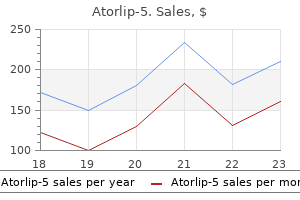
Order 5 mg atorlip-5 with visa
Presentation mostly included a history of nasal obstruction, sinusitis, or unilateral epistaxis. Resected tumors included three major varieties: squamous cell carcinoma (29), adenoid cystic carcinoma (14), and esthesioneuroblastoma (26). Of observe, ameloblastoma and meningioma are included on this evaluation as both neoplasms exhibited high-grade malignant options and have been handled with excision. The technical considerations on this chapter reflect the experience in treating these patients. Surgical Planning and Technology Several technological developments and instruments assist in the execution of endoscopic and endoscopic-assisted surgery, and these are reviewed intimately in different chapters. However, you will need to understand how much expertise has enabled the use of minimally invasive strategies. It also allows identification and resection of all visible tumor from recesses discovered throughout the anterior cranium base. This tumor is seen obstructing the nasal cavity, displaying the vascularity and surrounding constructions, which assist in planning. Adjunctive Techniques and Considerations Endoscopic devices enable wide drainage of sinuses adjacent to anterior skull base resections. Angiography and embolization of vascular tumors greatly cut back bleeding and permit a dry field by which to use the microscopic view offered by endoscopic telescopes to assure complete removing is accomplished. Although the invasive nature of aggressive squamous cell carcinomas can result in cranium base erosion and central invasion, the anatomy of this area favors tumor enlargement by the path of least resistance into the nasal and sinus space earlier than precise skull base erosion happens. This is particularly the case with 212 Rhinology and Endoscopic Skull Base Surgery much less aggressive esthesioneuroblastomas and adenoid cystic carcinomas, which made up 40% of the circumstances in our series. Both these constructions present effective obstacles to central invasion, as does the periorbital membrane surrounding the soft tissues of the attention and the carotid sheath surrounding these vessels.

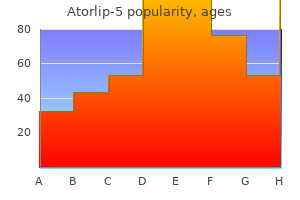
Atorlip-5 5 mg mastercard
Dorsal column group, however, is opposite, and cervical fibers are most superficial, resulting in loss of discriminating touch, vibration, or proprioception previous to similar findings within the decrease physique. Etiology and pathophysiology Extradural � Degenerative backbone disease: � Herniated disc. Clinical options Clinical features of an extrinsic wire lesion rely upon each the extent of the spinal twine concerned and the etiology of the compression. Clinical findings rely upon the twine degree and tracts affected (see syndromes described above): � Brown�Sequard (hemicord). Etiology and pathophysiology Predisposing elements include: � Narrowing of the spinal canal in the sagittal (anteroposterior) airplane: 11�12 mm (0. Reduction in crosssectional space of the wire by 30% or more, to a worth of about 60 mm2 or less, ends in signs and indicators. The mechanism may be direct or indirect compression: � Direct: traumatic compression and irregular motion. Clinical options Clinical myelopathy syndrome with or without signs and signs of cervical radiculopathy: � Neck and arm pain in some. Cervical disc protrusions are seen in about 30% of neurologically asymptomatic individuals over forty years old. Spinal twine impingement (a concave defect within the spinal wire adjacent to a site of disc bulging, without obliteration of the subarachnoid space posterior to the cord) is seen in about one-sixth of neurologically asymptomatic people under sixty five years and one-quarter over sixty five years. Cord compression (with obliteration of the posterior subarachnoid space) can also be neurologically asymptomatic but often the proportion discount in twine space in asymptomatic folks is properly below 30% (usually below 15%). Absence of the fat sign from inside the root canal, in addition to obvious abnormal structural defect. Plain movies of the cervical backbone are useful as a outcome of they show narrowing of the spinal canal, osteophytes arising from the posterior surfaces of degenerate discs and at the neurocentral joints, and the alignment of the vertebral bodies. Spinal cord/root compression includes: � Indentation, flattening, and distortion of the spinal cord similar to the spondylotic protrusions (685).
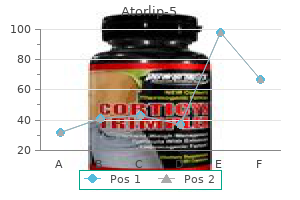
Purchase atorlip-5 5 mg fast delivery
Encephalocele and Glioma the presence of neural tissue in the nose or sinonasal cavity can happen from abnormal embryological improvement. A nasal glioma accommodates heterotopic rests of mind tissue with or without rudimentary connection to the mind. Gliomas may be seen throughout the sinonasal cavity or extranasally as a mass on the nasal dorsum or glabella. There are multiple theories for the event of encephaloceles and gliomas, which describe abnormal deposition of neural tissue throughout embryogenesis, failure of tissue separation during neuropore closure, and abnormal neural crest cell migration at the cranium base. The dimension and location of the encephalocele will decide the medical presentation. External nasal lesions are sometimes seen early, whereas intranasal and sinus encephaloceles will not be recognized till later in life as an incidental discovering on imaging. Other attainable presenting signs of an encephalocele include nasal obstruction, sinusitis from sinus outflow obstruction, or meningitis from unfold of nasal flora to the intracranial cavity. Nasal Lacrimal Anomalies the nasolacrimal duct forms by infolding of the lateral process of the nasal placode. The involution of ectoderm is completed with detachment from the exterior facial floor and connection as a cylindrical construction. During this process, any ectoderm cell that turns into trapped throughout the mesenchymal tube can proliferate to form a lacrimal cyst. These cysts can present with nasolacrimal obstruction causing epiphora or dacryocystitis, or with nasal obstruction from an intranasal mass within the anterior nasal cavity. Newborns with large or bilateral nasolacrimal cysts can reveal airway compromise within the postnatal interval. Pyriform Aperture Stenosis Congenital nasal obstruction may be attributable to narrowing of the anterior nasal cavity because of pyriform aperture stenosis. Conclusion Embryological growth of the nostril and paranasal sinuses is a fancy sequence of events. Numerous anatomical variations in addition to disorders that arise from irregular embryological growth lead to clinically relevant entities that should be acknowledged by head and neck surgeons. Understanding of the embryological origins and pathways by which the sinuses develop will assist surgeons optimize their outcomes and forestall issues. The Nose, Paranasal Sinuses, Nasolacrimal Passageways and Olfactory Organ in Man: A Genetic, Developmental and Anatomico-Physiological Consideration.
Buy generic atorlip-5 5 mg
Toxoplasma encephalitis usually starts with a focal deficit (hemiplegia, for instance), convulsions, complications, fever, or confusion. If antibody is absent, or if the affected person has taken trimethoprim-sulfamethoxazole prophylaxis, another prognosis ought to be thought of first. Treat utilizing a combination of sulfadiazine and pyrimethamine, with added folinic acid. If the IgG antibodies are positive and the pictures are typical, empiric treatment is warranted. Steroids (intravenous dexamethasone 4 mg each 6 hours) may be administered to diminish the cerebral edema. This remedy must be continued for 4�6 weeks; after that, secondary prevention utilizing oral sulfadiazine 2 g day by day and oral pyrimethamine 25 mg day by day is indicated. As an alternative, clindamycin (600 mg every 6 hours, and then 600 mg each 12 hours) may be mixed with pyrimethamine; tolerance of that regimen is normally higher, but efficacy is lowered. Another various is atovaquone suspension (750 mg every 12 or eight hours) mixed with pyrimethamine. Clinical signs usually progress quickly over a couple of weeks, with confusion, focal indicators, and headache. Although these tumors are delicate to radiation and chemotherapy, the prognosis is poor. Magnetic resonance imaging or computed tomography scan shows one or two irregular enhancing lesions. Positron emission tomography and single-photon emission computed tomography scans are useful in differentiating lymphoma from toxoplasmosis and progressive multifocal leukoencephalopathy. The disease starts insidiously with loss of reminiscence or dysphasia, visible disturbances, aphasia, or motor signs-or, more rarely, with convulsions. No specific therapy is on the market (cidofovir and cytosine arabinoside have been tried, with inconsistent results). Cryptococcosis occurs in profoundly immunosuppressed patients and is particularly frequent in Africa and in the United States. The illness normally starts with complications and fever; curiously, meningeal indicators could be absent.
Order 5 mg atorlip-5 otc
The persistence and severity of the neurologic injury reflect the site of ischemia, the period and severity of the anoxic insult, and the metabolic demands of the cells. The mind cells that are most weak to hypoxia are neurons, followed in order of lowering sensitivity by oligodendroglia, astrocytes, and endothelial cells. Consequently, cerebral anoxia manifests itself as clinical features of dysfunction of those neurons. Clinical features Mild hypoxia Mild hypoxia can happen from insults similar to mountaineering or continual low stage carbon monoxide poisoning. Symptoms and indicators embody: � Inattentiveness, irritability, fatigue, headache, nausea, and mild confusion. Moderate hypoxia After a short period of coma, consciousness is regained and some sufferers pass shortly via an acute posthypoxic phase, characterized by variable levels of confusion, visible agnosia, or any one of a quantity of types of movement disorder. Others, nonetheless, are left with everlasting neurologic sequelae of various combinations of one of many post-hypoxic syndromes: � Persistent coma or stupor (see below). One to four weeks later, the medical triad develops of mental deterioration (apathy, confusion, irritability, and occasionally agitation or mania), sphincteric incontinence, and gait disturbances consequent to frontal lobe and basal ganglia dysfunction. Some sufferers expertise persisting late sequelae including reminiscence disturbances and parkinsonism; in others the neurologic syndrome progresses with weak point, shuffling gait, diffuse rigidity and spasticity, incontinence, coma, and demise after 1�2 weeks; not often, the hypoxic episode is adopted by a slow deterioration over weeks to months until the affected person is mute, inflexible, and helpless. Severe but not sustained hypoxia Initially sufferers are comatose with eyes barely divergent and immobile, pupils reactive, limbs inert and flaccid or rigid, and tendon reflexes that are diminished. Within a couple of minutes of restoring cardiac action and respiration, generalized convulsions and muscle twitches (myoclonus) may happen. After about 1 week or more, the eyes open, initially in response to pain and later spontaneously, the eyelids blink in response to any threat to the eye, and the eyes rove around inattentively. The individual may survive on this vegetative state (mute, unresponsive, and unaware of the environment) for weeks, months or years (see p. Carbon monoxide poisoning produces an analogous image however with extra basal ganglia involvement, seen as symmetric low density.
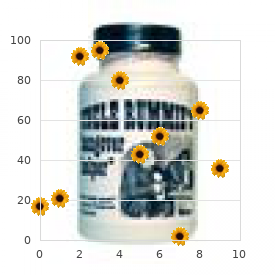
Generic atorlip-5 5 mg fast delivery
Clues to an alternative prognosis are the presence of additional nonparkinsonian options and a partial or absent response to levodopa and dopamine agonists. Progression of atypical features over time and response to antiparkinsonian medicines normally enhance the knowledge of diagnosis. Diagnosis A medical prognosis could be made with confidence when: � There are two of the four cardinal scientific features of parkinsonism, including bradykinesia and one of the following: tremor (present in 80%), rigidity, and disturbed postural reflexes. Pathology � Loss (50%) of melanin-containing, pigmented, dopaminergic neurons in the substantia nigra; preferentially affects the ventrolateral substantia nigra pars compacta which initiatives to the posterior putamen, with less involvement of the medial tegmental pigmented neurons that project to the caudate nucleus (561�564). The brainstem pathology takes an upward course with cortical involvement following. With the addition of additional predilection sites, the pathology within the previously involved areas increases. Treatment7 the nice majority of sufferers are adequately managed within the outpatient setting. Degenerative diseases of the nervous system 587 Commence medical remedy (dopamine replacement) on the lowest required dose and proceed with dose increases slowly to find a way to decrease danger of antagonistic effects corresponding to nausea, dizziness, or confusion, significantly in the elderly (Table ninety eight, next page). These predictable motor fluctuations are finest managed by aiming for relatively fixed ranges of levodopa by lowering the time interval between each dose and prescribing extra frequent, and generally smaller, doses of levodopa. The addition of a dopamine agonist or an enzyme inhibitor (see below) could also be helpful. However, this drug could have less bioavailability and could additionally be troublesome to titrate in additional advanced sufferers. Adverse results embody dry mouth, psychological confusion, hallucinations, blurred vision, and difficulty initiating micturition and urinary retention. Anticholinergics are contraindicated in glaucoma, and ought to be prevented, or used with warning, within the aged due to the high incidence of confusion and only modest antiparkinsonian profit. Amantadine Amantadine is accredited as an antiviral agent, and has unclear but doubtless multifactorial mechanisms of motion including: � Anticholinergic (antimuscarinic) results.
Real Experiences: Customer Reviews on Atorlip-5
Sulfock, 56 years: Occasionally, bleeding can be encountered from anterior intercavernous connections; this is controlled with microfibrillar collagen, stress, or bipolar cautery.
Pedar, 53 years: The roof transitions posteriorly to turn out to be the common cranium base between the sinus and the sella turcica-allowing transphenoidal approach to the pituitary gland.
Ugrasal, 34 years: For example, the rodent vas deferens is equipped with dense sympathetic innervation, and stimulation of the nerves ends in a biphasic mechanical response that consists of an preliminary speedy twitch adopted by a sustained contraction.
8 of 10 - Review by M. Mortis
Votes: 40 votes
Total customer reviews: 40
References
- Schwartz D, Amir L, Dichter R, et al. The use of a powered device for intraosseous drug and fl uid administration in a national EMS: a 4-year experience. J Trauma. 2008;64(3):650-654; discussion 654-655.
- Visentin S, Wu SN, Belardinelli L: Adenosine-induced changes in atrial action potential: Contribution of Ca and K currents, Am J Physiol 258:H1070-H1078, 1990.
- Gnekow AK, Falkenstein F, von Hornstein S, et al. Long-term follow-up of the multicenter, multidisciplinary treatment study HIT-LGG-1996 for lowgrade glioma in children and adolescents of the German Speaking Society of Pediatric Oncology and Hematology. Neuro Oncol 2012; 14(10):1265-1284.
- Sandoz, R. (1976). Some physical mechanisms and effects of spinal adjustments. Annals of the Swiss Chiropractic Association, 6, 91n141.
- Senz A, Nunnink L. Inotrope and vasopressor use in the emergency department. EMA 2009;21:342-51.
- Bella AJ, Sener A, Foell K, et al: Nonpalpable scarring of the penile septum as a cause of erectile dysfunction: an atypical form of Peyronieis disease, J Sex Med 4:226n230, 2007.

